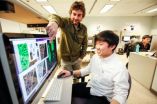(Press-News.org) INDIANAPOLIS— A study conducted by local high school students and faculty from the Department of Computer and Information Science in the School of Science at Indiana University-Purdue University Indianapolis reveals new information about the motor circuits of the brain that may one day help those developing therapies to treat conditions such as stroke, schizophrenia, spinal cord injury or Alzheimer's disease.
"MRI and CAT scans of the human brain can tell us many things about the structure of this most complicated of organs, formed of trillions of neurons and the synapses via which they communicate. But we are a long way away from having imaging techniques that can show single neurons in a complex brain like the human brain," said Gavriil Tsechpenakis, Ph.D., assistant professor of computer science in the School of Science at IUPUI.
"But using the tools of artificial intelligence, specifically computer vision and image processing, we are able to visualize and process actual neurons of model organisms. Our work in the brain of a model organism—the fruit fly—will help us and other researchers move forward to more complex organisms with the ultimate goal of reconstructing the human central nervous system to gain insight into what goes wrong at the cellular level when devastating disorders of the brain and spinal cord occur. This understanding may ultimately inform the treatment of these conditions," said Tsechpenakis.
In this study, which processed images and reconstructed neuronal motor circuitry in the brain, the researchers, who included two Indianapolis high school students—Rachel Stephens and Tiange (Tony) Qu—collected and analyzed data on minute structures over various developmental stages, efforts linking neuroscience and computer science.
"Both high school students who worked on this study performed neuroscience and computation efforts similar to that conducted elsewhere by graduate students. It was impressive to see what sophisticated and key work they could—with mentoring—do," said Tsechpenakis.
Qu said the work was initially rather scary and intimidating but that he rapidly grew to appreciate the opportunity to work in the School of Science lab. "Unlike high school, we were not told how to get from point A to point B. Dr. Tsechpenakis explained what point A and B were and taught us how to figure out how to get from A to B."
Qu, a 17-year-old senior at Ben Davis High School, now sees neuroscience as a potential college major with biomedical research as an eventual career goal. He continues to work in the lab after school focusing on change over time in fruit fly larvae motor neurons.
Stephens, a senior at North Central High School, said she enjoyed the collaborative nature of the research, with computer scientists and life scientists working together on a problem.
"Dr. Tsechpenakis made it clear to us that different perspectives are necessary, and the ability to think about a problem is more valuable than the education and training you've had," she said. "Before I joined the lab I hadn't really thought about how computer science could help heal." The 17-year-old plans a pre-med major in college and a career as a physician.
INFORMATION:
Stephens and Qu were supported by the National Science Foundation and the Indianapolis Project SEED High School Summer Research Program.
"Part-based motor neuron recognition in the Drosophila ventral nerve cord" appears online in advance of publication in the peer reviewed journal NeuroImage. Study co-authors, in addition to senior author Tsechpenakis and high school students Stephens and Qu, are IUPUI post-doctoral fellow Xiao Chang, Ph.D., (first author) and Michael D. Kim, Ph.D. and Akira Chiba, Ph.D., biologists from the University of Miami. The study was funded by National Science Foundation awards (1252597 and 1062405) to Tsechpenakis.
The School of Science at IUPUI is committed to excellence in teaching, research and service in the biological, physical, behavioral and mathematical sciences. The school is dedicated to being a leading resource for interdisciplinary research and science education in support of Indiana's effort to expand and diversify its economy. For more information, visit science.iupui.edu.
IUPUI researchers use computers to 'see' neurons to better understand brain function
2014-03-06
ELSE PRESS RELEASES FROM THIS DATE:
Complications following surgery predict costly readmissions
2014-03-06
The presence – or absence – of complications following surgery is a strong indicator of which patients are likely to be readmitted to the hospital in the 30 days following their procedure, according to a study published today in JAMA Surgery. Predicting which patients are most likely to experience complications using a simple online tool may allow healthcare professionals to flag patients at high risk of readmission in real time and alter care to reduce expensive trips back to the hospital.
The study examined more than 142,000 patients who had non-cardiac surgery using ...
Listening to whispers at the water cooler
2014-03-06
Just as she was about to retire, Lily Ledbetter, a production supervisor at an Alabama tire plant, learned that her employers had financially discriminated against her throughout her career. She filed suit for pay discrimination, losing due to a statute of limitations on equal-pay suits. As a result, President Barack Obama signed the Lily Ledbetter Fair Pay Act into law in 2009, drawing attention to the effects of pay secrecy on the workplace.
Now Prof. Peter Bamberger of Tel Aviv University's Recanati School of Business and Dr. Elena Belogolovsky of Cornell University's ...
Strong teams attract crowds for international cricket
2014-03-06
The strength of the team — not the promise of a close contest — is the biggest draw to crowds in international cricket, new research has found.
The findings from the study, published in the journal Applied Economics, appear to contradict previous research which suggested that attendance is largely determined by how closely matched the two teams are during a game.
Economists Dr Abhinav Sacheti and Professor David Paton from Nottingham University Business School, in collaboration with Dr Ian Gregory-Smith from the University of Sheffield, analysed the number of spectators ...
MIT team proposes storing extra rocket fuel in space for future missions
2014-03-06
Future lunar missions may be fueled by gas stations in space, according to MIT engineers: A spacecraft might dock at a propellant depot, somewhere between the Earth and the moon, and pick up extra rocket fuel before making its way to the lunar surface.
Orbiting way stations could reduce the fuel a spacecraft needs to carry from Earth — and with less fuel onboard, a rocket could launch heavier payloads, such as large scientific experiments.
Over the last few decades, scientists have proposed various designs, such as building a fuel-manufacturing station on the moon ...
Researchers identify target for shutting down growth of prostate cancer cells
2014-03-06
DALLAS – March 4, 2014 – Scientists at UT Southwestern Medical Center have identified an important step toward potentially shutting down the growth of prostate cancer cells.
Dr. Ralf Kittler, Assistant Professor of Pharmacology, studies ERG, a protein that facilitates the transformation of normal prostate cells into cancer cells. His lab found that an enzyme called USP9X protects ERG from degradation and subsequently found that a molecule called WP1130 can block USP9X and lead to the destruction of ERG.
"We now have a target that we could potentially exploit to develop ...
Thirty percent of adults with attention deficit disorder report childhood physical abuse
2014-03-06
Thirty percent of adults with Attention Deficit Disorder or Attention Deficit Hyperactivity Disorder (ADD/ADHD) report they were physically abused before they turned 18. This compares to seven per cent of those without ADD/ADHD who were physically abused before 18. The results were in a study published in this week's online Journal of Aggression, Maltreatment, and Trauma.
"This strong association between abuse and ADD/ADHD was not explained by differences in demographic characteristics or other early adversities experienced by those who had been abused," says lead author ...
Pharmaceutical companies' DC marketing efforts increase to nearly $98 million
2014-03-06
WASHINGTON, DC (March 6, 2014)— Drug companies spent $97.5 million marketing pharmaceuticals in the District of Columbia in 2012, with $30.5 million (31.3%) of that spending taking the form of payments and gifts to physicians, hospitals, and other healthcare providers, according to a report by researchers at the George Washington University School of Public Health and Health Services (SPHHS).
These expenditures represent the first year-on-year spending increase by drug companies since 2007. Between 2007 and 2011, spending declined each year to a low of $84 million in ...
IT security for the daily life: Withdrawing money at cash machines with 'Google Glass'
2014-03-06
This news release is available in German.
Taking photos with a wink, checking one's calendar with a glance of the right eye, reading text messages — the multinational cooperation Google wants to make it possible with Google Glass. But what IT experts celebrate as a new milestone makes privacy groups skeptical. So far, few people have access to the prototype to test how it can be used in daily life. "Thanks to the Max Planck Institute for Informatics we are one of the few universities in Germany that can do research with Google Glass", says Dominique Schröder, assistant ...
Study: Classroom focus on social and emotional skills can lead to academic gains
2014-03-06
VIDEO:
This video shows: "Efficacy of the Responsive Classroom Approach:
Results from a Three Year, Longitudinal Randomized Controlled Trial. "
Published Online First in:
American Educational Research Journal
March 6, 2014
Authors:
Sarah Rimm-Kaufman, Ross A. Larsen, Alison...
Click here for more information.
WASHINGTON, D.C., March 6, 2014 ─ Classroom programs designed to improve elementary school students' social and emotional skills can also ...
Dr. Dwight Rouse addresses rapid increase in cesarean birth rates
2014-03-06
In 2011, one in three pregnant women in the U.S. delivered babies by cesarean delivery. While cesarean delivery may be life-saving for the mother, the baby or both, the rapid increase in cesarean birth rates since 1996 without clear indication raises concerns that this type of delivery may be overused.
Dwight J. Rouse, MD, MSPH, a specialist in the Division of Maternal-Fetal Medicine at Women & Infants Hospital of Rhode Island and a professor of obstetrics and gynecology at The Warren Alpert Medical School of Brown University, has co-authored the first in a new, joint ...



